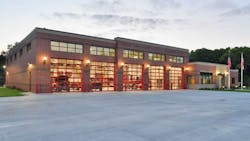One of the most dramatic changes to the tradition-bound U.S. fire service, in my opinion, occurred in 1986. Attorney Neil Rossman successfully sued the Peter Pirsch Company on behalf of Joe Tynan, a Brookline, MA, firefighter who fell from the open cab of a Prisch fire truck and was critically injured. Almost overnight, new fire trucks featured enclosed cabs. In addition, the number of firefighter accidents decreased dramatically.
I believe another significant change occurred in the fire service in 2014 when Architect Paul Erickson of LeMay Erickson Willcox Architects introduced the concept of Hot Zone design for fire stations during the Station Design Conference in Baltimore, MD.
Erickson described how firefighters returning from fires were bringing carcinogens and toxins from the incidents into the fire station, contaminating apparatus bays through and into living areas. By creating Red (contaminated), Yellow (transition areas) and Green (clean) zones, contaminants could be restricted from continued firefighter exposure. The research on firefighter exposure has raised awareness and been adopted, especially in light of increasing statistics of firefighters and cancer.
Erickson has continued to give presentations at annual fire station conferences, F.I.E.R.O., the Fire Department Safety Officers Association’s annual Apparatus Symposium, and the Metro Chiefs. Besides educating fire chiefs, building committee members, safety officers and municipal leaders, Erickson has educated architects across the U.S. and Canada.
Last year, the 2018 Station Design Awards saw several entries that implemented the Hot Zone design, including the Eau Claire, WI, Fire Station #10, commended by the Station Design Award judges. Since buildings can be in design for several years, there is no doubt we will continue to see an increase of new stations that have adopted the Hot Zone design to reduce exposure to carcinogens by firefighters.
This year, the Station Design Conference offered a number of innovative ideas and new trends that will continue to ensure firefighters and first responders are both physically and mentally healthy, as well as safe.
In Erickson’s presentation on “Immersive Design,” he referred to medical and healthcare’s architecture and its increased use of natural light and exterior windows to greenery and nature. Also, Erickson noted the use of paint color for rooms in fire stations to match the activities: shades of blue for sleeping, green for living areas and red for more active rooms.
By the way, we wrote to U.S. Fire Administrator Keith Bryant and raised awareness of Erickson’s efforts to reduce firefighter exposures to contaminants in fire stations and his education shared with other architects on the need for Hot Zone designs. Administrator Bryant sent a letter to Erickson acknowledging his work, which we presented to him at the opening of the 2019 Station Design Conference.
We believe, not unlike the abrupt changes to fire apparatus over 30 years ago and apparatus’ subsequent evolution, fire stations are also on a new path to not only serve but protect first responders more so than ever before in the history of the U.S. fire service.






